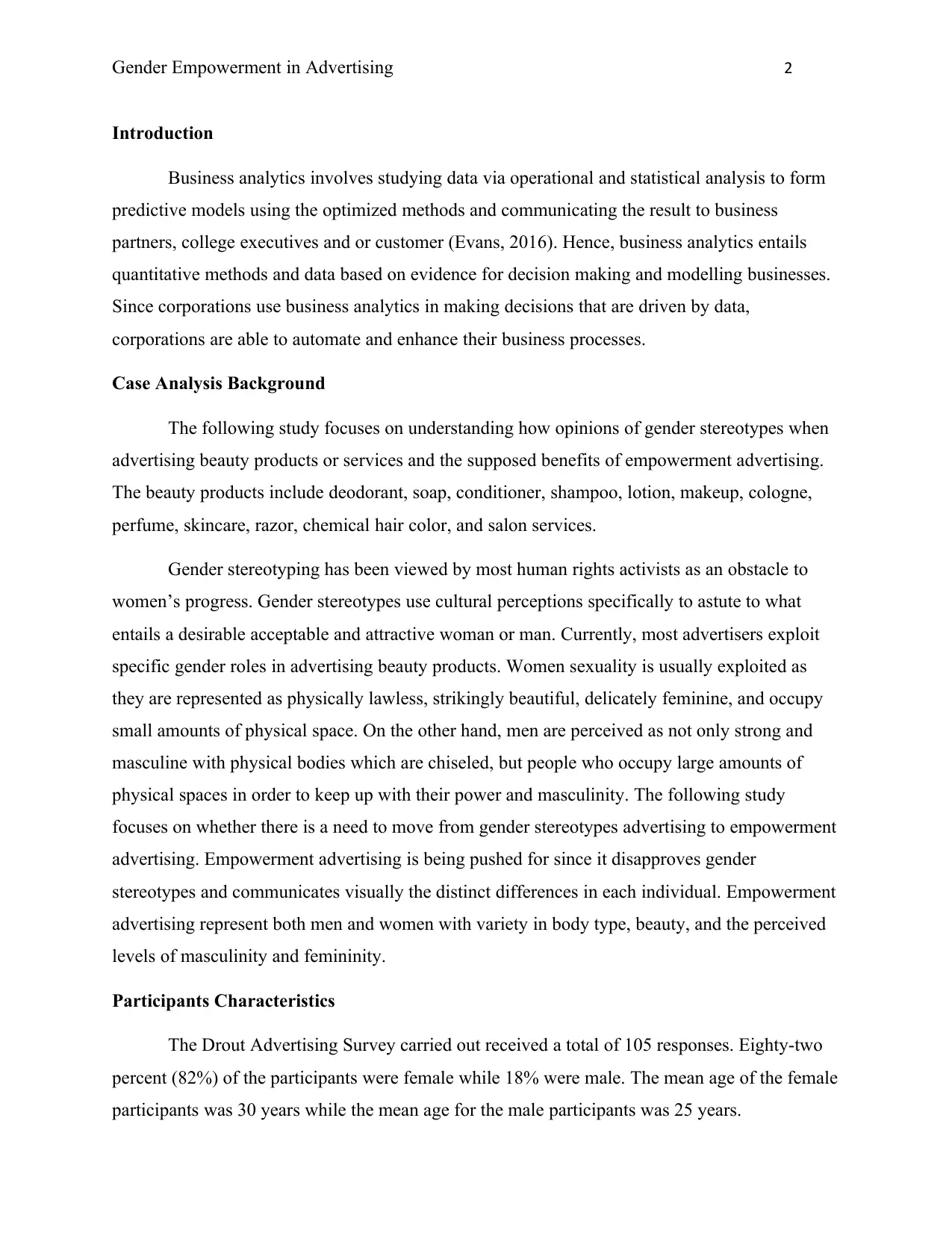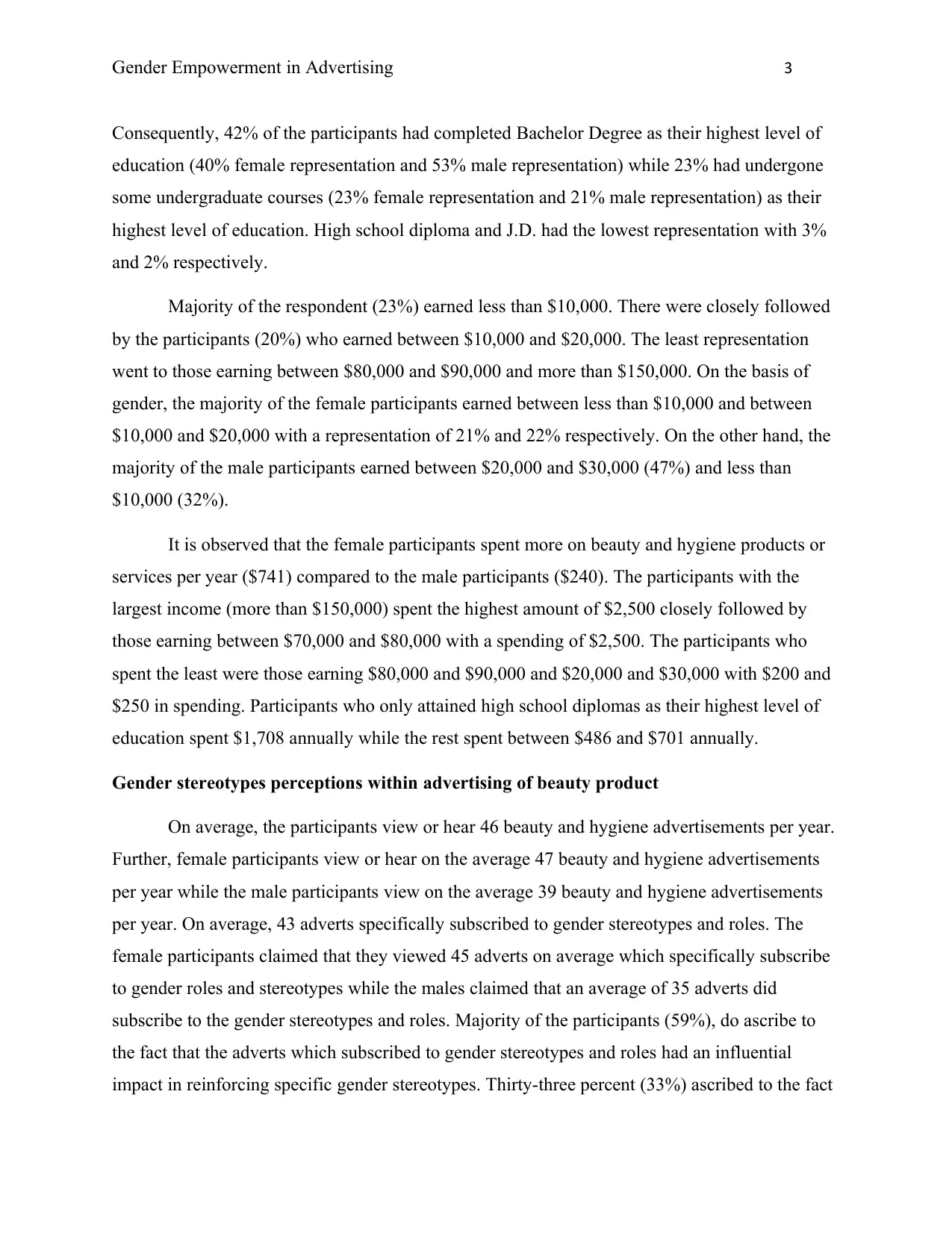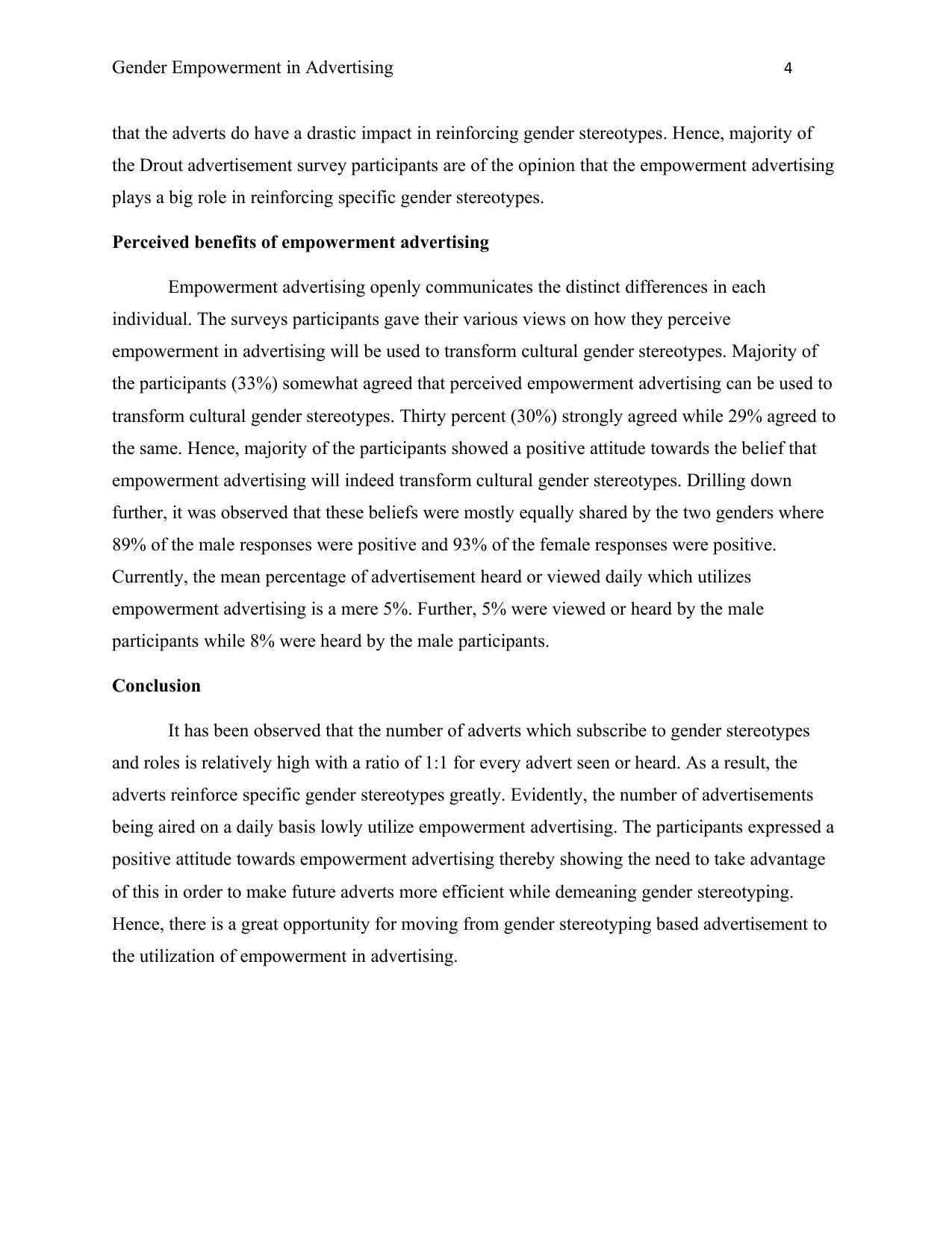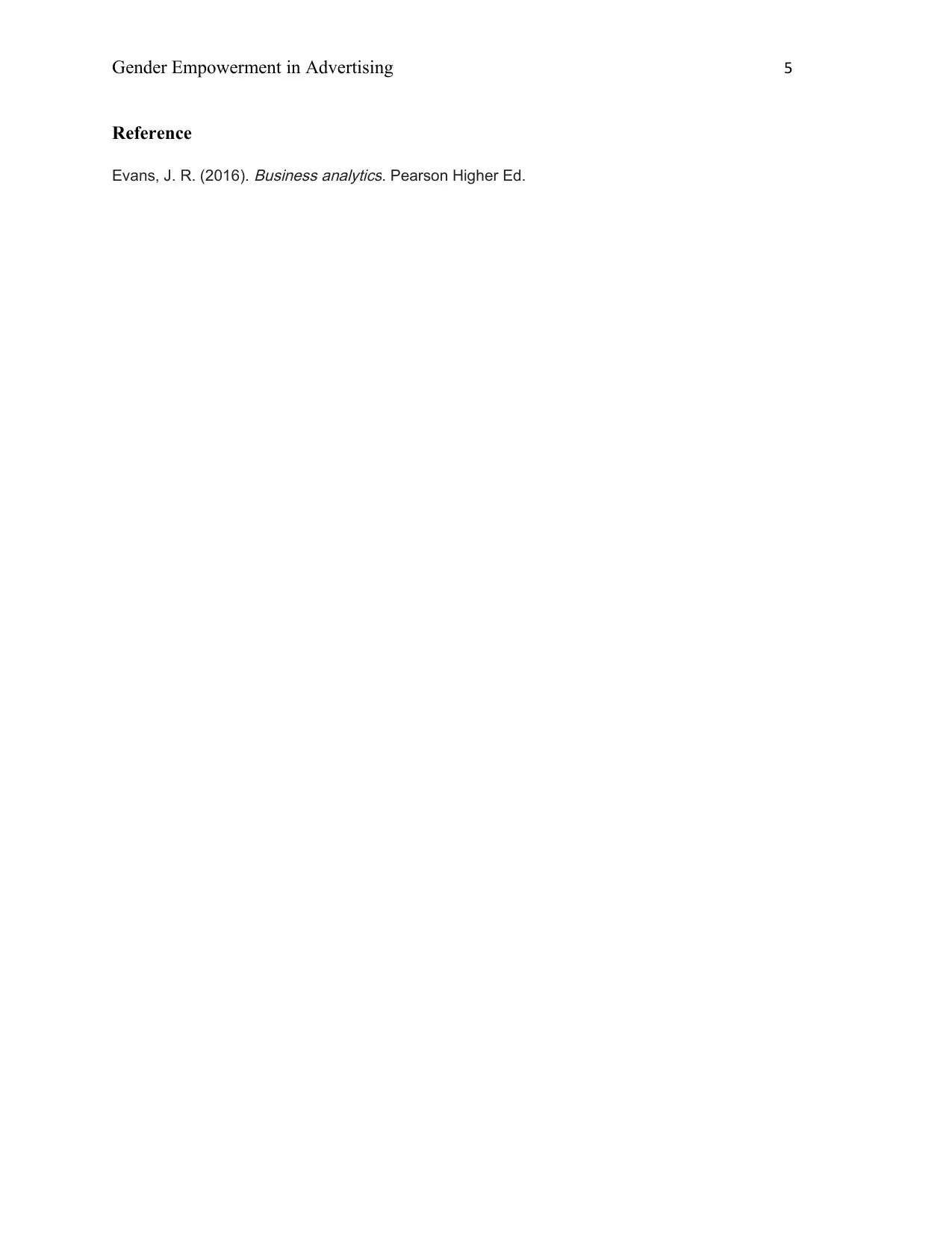Drout Advertising Survey: Gender Empowerment Impact in Advertising
VerifiedAdded on 2023/03/30
|5
|1060
|166
Report
AI Summary
This report analyzes the results of the Drout Advertising Survey, focusing on gender empowerment in advertising, particularly within the beauty product sector. The study investigates the influence of gender stereotypes in advertising, examining how these stereotypes are perceived by participants and their impact on reinforcing societal norms. The research explores the shift from traditional gender stereotyping to empowerment advertising, assessing the perceived benefits of this approach. The survey involved 105 participants, primarily female, and gathered data on their views on beauty and hygiene advertisements, their spending habits, and their opinions on the influence of gender roles in advertising. The findings reveal a high prevalence of gender stereotypes in advertisements and their reinforcement of specific gender roles. The report concludes by highlighting the potential of empowerment advertising to transform cultural gender stereotypes and recommends a shift towards more inclusive and diverse representation in future advertising campaigns.

RUNNING HEADER: GENDER EMPOWERMENT IN ADVERTISING 1
Gender Empowerment in Advertising
Student’s Name:
Institution:
Gender Empowerment in Advertising
Student’s Name:
Institution:
Paraphrase This Document
Need a fresh take? Get an instant paraphrase of this document with our AI Paraphraser

Gender Empowerment in Advertising 2
Introduction
Business analytics involves studying data via operational and statistical analysis to form
predictive models using the optimized methods and communicating the result to business
partners, college executives and or customer (Evans, 2016). Hence, business analytics entails
quantitative methods and data based on evidence for decision making and modelling businesses.
Since corporations use business analytics in making decisions that are driven by data,
corporations are able to automate and enhance their business processes.
Case Analysis Background
The following study focuses on understanding how opinions of gender stereotypes when
advertising beauty products or services and the supposed benefits of empowerment advertising.
The beauty products include deodorant, soap, conditioner, shampoo, lotion, makeup, cologne,
perfume, skincare, razor, chemical hair color, and salon services.
Gender stereotyping has been viewed by most human rights activists as an obstacle to
women’s progress. Gender stereotypes use cultural perceptions specifically to astute to what
entails a desirable acceptable and attractive woman or man. Currently, most advertisers exploit
specific gender roles in advertising beauty products. Women sexuality is usually exploited as
they are represented as physically lawless, strikingly beautiful, delicately feminine, and occupy
small amounts of physical space. On the other hand, men are perceived as not only strong and
masculine with physical bodies which are chiseled, but people who occupy large amounts of
physical spaces in order to keep up with their power and masculinity. The following study
focuses on whether there is a need to move from gender stereotypes advertising to empowerment
advertising. Empowerment advertising is being pushed for since it disapproves gender
stereotypes and communicates visually the distinct differences in each individual. Empowerment
advertising represent both men and women with variety in body type, beauty, and the perceived
levels of masculinity and femininity.
Participants Characteristics
The Drout Advertising Survey carried out received a total of 105 responses. Eighty-two
percent (82%) of the participants were female while 18% were male. The mean age of the female
participants was 30 years while the mean age for the male participants was 25 years.
Introduction
Business analytics involves studying data via operational and statistical analysis to form
predictive models using the optimized methods and communicating the result to business
partners, college executives and or customer (Evans, 2016). Hence, business analytics entails
quantitative methods and data based on evidence for decision making and modelling businesses.
Since corporations use business analytics in making decisions that are driven by data,
corporations are able to automate and enhance their business processes.
Case Analysis Background
The following study focuses on understanding how opinions of gender stereotypes when
advertising beauty products or services and the supposed benefits of empowerment advertising.
The beauty products include deodorant, soap, conditioner, shampoo, lotion, makeup, cologne,
perfume, skincare, razor, chemical hair color, and salon services.
Gender stereotyping has been viewed by most human rights activists as an obstacle to
women’s progress. Gender stereotypes use cultural perceptions specifically to astute to what
entails a desirable acceptable and attractive woman or man. Currently, most advertisers exploit
specific gender roles in advertising beauty products. Women sexuality is usually exploited as
they are represented as physically lawless, strikingly beautiful, delicately feminine, and occupy
small amounts of physical space. On the other hand, men are perceived as not only strong and
masculine with physical bodies which are chiseled, but people who occupy large amounts of
physical spaces in order to keep up with their power and masculinity. The following study
focuses on whether there is a need to move from gender stereotypes advertising to empowerment
advertising. Empowerment advertising is being pushed for since it disapproves gender
stereotypes and communicates visually the distinct differences in each individual. Empowerment
advertising represent both men and women with variety in body type, beauty, and the perceived
levels of masculinity and femininity.
Participants Characteristics
The Drout Advertising Survey carried out received a total of 105 responses. Eighty-two
percent (82%) of the participants were female while 18% were male. The mean age of the female
participants was 30 years while the mean age for the male participants was 25 years.

Gender Empowerment in Advertising 3
Consequently, 42% of the participants had completed Bachelor Degree as their highest level of
education (40% female representation and 53% male representation) while 23% had undergone
some undergraduate courses (23% female representation and 21% male representation) as their
highest level of education. High school diploma and J.D. had the lowest representation with 3%
and 2% respectively.
Majority of the respondent (23%) earned less than $10,000. There were closely followed
by the participants (20%) who earned between $10,000 and $20,000. The least representation
went to those earning between $80,000 and $90,000 and more than $150,000. On the basis of
gender, the majority of the female participants earned between less than $10,000 and between
$10,000 and $20,000 with a representation of 21% and 22% respectively. On the other hand, the
majority of the male participants earned between $20,000 and $30,000 (47%) and less than
$10,000 (32%).
It is observed that the female participants spent more on beauty and hygiene products or
services per year ($741) compared to the male participants ($240). The participants with the
largest income (more than $150,000) spent the highest amount of $2,500 closely followed by
those earning between $70,000 and $80,000 with a spending of $2,500. The participants who
spent the least were those earning $80,000 and $90,000 and $20,000 and $30,000 with $200 and
$250 in spending. Participants who only attained high school diplomas as their highest level of
education spent $1,708 annually while the rest spent between $486 and $701 annually.
Gender stereotypes perceptions within advertising of beauty product
On average, the participants view or hear 46 beauty and hygiene advertisements per year.
Further, female participants view or hear on the average 47 beauty and hygiene advertisements
per year while the male participants view on the average 39 beauty and hygiene advertisements
per year. On average, 43 adverts specifically subscribed to gender stereotypes and roles. The
female participants claimed that they viewed 45 adverts on average which specifically subscribe
to gender roles and stereotypes while the males claimed that an average of 35 adverts did
subscribe to the gender stereotypes and roles. Majority of the participants (59%), do ascribe to
the fact that the adverts which subscribed to gender stereotypes and roles had an influential
impact in reinforcing specific gender stereotypes. Thirty-three percent (33%) ascribed to the fact
Consequently, 42% of the participants had completed Bachelor Degree as their highest level of
education (40% female representation and 53% male representation) while 23% had undergone
some undergraduate courses (23% female representation and 21% male representation) as their
highest level of education. High school diploma and J.D. had the lowest representation with 3%
and 2% respectively.
Majority of the respondent (23%) earned less than $10,000. There were closely followed
by the participants (20%) who earned between $10,000 and $20,000. The least representation
went to those earning between $80,000 and $90,000 and more than $150,000. On the basis of
gender, the majority of the female participants earned between less than $10,000 and between
$10,000 and $20,000 with a representation of 21% and 22% respectively. On the other hand, the
majority of the male participants earned between $20,000 and $30,000 (47%) and less than
$10,000 (32%).
It is observed that the female participants spent more on beauty and hygiene products or
services per year ($741) compared to the male participants ($240). The participants with the
largest income (more than $150,000) spent the highest amount of $2,500 closely followed by
those earning between $70,000 and $80,000 with a spending of $2,500. The participants who
spent the least were those earning $80,000 and $90,000 and $20,000 and $30,000 with $200 and
$250 in spending. Participants who only attained high school diplomas as their highest level of
education spent $1,708 annually while the rest spent between $486 and $701 annually.
Gender stereotypes perceptions within advertising of beauty product
On average, the participants view or hear 46 beauty and hygiene advertisements per year.
Further, female participants view or hear on the average 47 beauty and hygiene advertisements
per year while the male participants view on the average 39 beauty and hygiene advertisements
per year. On average, 43 adverts specifically subscribed to gender stereotypes and roles. The
female participants claimed that they viewed 45 adverts on average which specifically subscribe
to gender roles and stereotypes while the males claimed that an average of 35 adverts did
subscribe to the gender stereotypes and roles. Majority of the participants (59%), do ascribe to
the fact that the adverts which subscribed to gender stereotypes and roles had an influential
impact in reinforcing specific gender stereotypes. Thirty-three percent (33%) ascribed to the fact
⊘ This is a preview!⊘
Do you want full access?
Subscribe today to unlock all pages.

Trusted by 1+ million students worldwide

Gender Empowerment in Advertising 4
that the adverts do have a drastic impact in reinforcing gender stereotypes. Hence, majority of
the Drout advertisement survey participants are of the opinion that the empowerment advertising
plays a big role in reinforcing specific gender stereotypes.
Perceived benefits of empowerment advertising
Empowerment advertising openly communicates the distinct differences in each
individual. The surveys participants gave their various views on how they perceive
empowerment in advertising will be used to transform cultural gender stereotypes. Majority of
the participants (33%) somewhat agreed that perceived empowerment advertising can be used to
transform cultural gender stereotypes. Thirty percent (30%) strongly agreed while 29% agreed to
the same. Hence, majority of the participants showed a positive attitude towards the belief that
empowerment advertising will indeed transform cultural gender stereotypes. Drilling down
further, it was observed that these beliefs were mostly equally shared by the two genders where
89% of the male responses were positive and 93% of the female responses were positive.
Currently, the mean percentage of advertisement heard or viewed daily which utilizes
empowerment advertising is a mere 5%. Further, 5% were viewed or heard by the male
participants while 8% were heard by the male participants.
Conclusion
It has been observed that the number of adverts which subscribe to gender stereotypes
and roles is relatively high with a ratio of 1:1 for every advert seen or heard. As a result, the
adverts reinforce specific gender stereotypes greatly. Evidently, the number of advertisements
being aired on a daily basis lowly utilize empowerment advertising. The participants expressed a
positive attitude towards empowerment advertising thereby showing the need to take advantage
of this in order to make future adverts more efficient while demeaning gender stereotyping.
Hence, there is a great opportunity for moving from gender stereotyping based advertisement to
the utilization of empowerment in advertising.
that the adverts do have a drastic impact in reinforcing gender stereotypes. Hence, majority of
the Drout advertisement survey participants are of the opinion that the empowerment advertising
plays a big role in reinforcing specific gender stereotypes.
Perceived benefits of empowerment advertising
Empowerment advertising openly communicates the distinct differences in each
individual. The surveys participants gave their various views on how they perceive
empowerment in advertising will be used to transform cultural gender stereotypes. Majority of
the participants (33%) somewhat agreed that perceived empowerment advertising can be used to
transform cultural gender stereotypes. Thirty percent (30%) strongly agreed while 29% agreed to
the same. Hence, majority of the participants showed a positive attitude towards the belief that
empowerment advertising will indeed transform cultural gender stereotypes. Drilling down
further, it was observed that these beliefs were mostly equally shared by the two genders where
89% of the male responses were positive and 93% of the female responses were positive.
Currently, the mean percentage of advertisement heard or viewed daily which utilizes
empowerment advertising is a mere 5%. Further, 5% were viewed or heard by the male
participants while 8% were heard by the male participants.
Conclusion
It has been observed that the number of adverts which subscribe to gender stereotypes
and roles is relatively high with a ratio of 1:1 for every advert seen or heard. As a result, the
adverts reinforce specific gender stereotypes greatly. Evidently, the number of advertisements
being aired on a daily basis lowly utilize empowerment advertising. The participants expressed a
positive attitude towards empowerment advertising thereby showing the need to take advantage
of this in order to make future adverts more efficient while demeaning gender stereotyping.
Hence, there is a great opportunity for moving from gender stereotyping based advertisement to
the utilization of empowerment in advertising.
Paraphrase This Document
Need a fresh take? Get an instant paraphrase of this document with our AI Paraphraser

Gender Empowerment in Advertising 5
Reference
Evans, J. R. (2016).
Business analytics. Pearson Higher Ed.
Reference
Evans, J. R. (2016).
Business analytics. Pearson Higher Ed.
1 out of 5
Your All-in-One AI-Powered Toolkit for Academic Success.
+13062052269
info@desklib.com
Available 24*7 on WhatsApp / Email
![[object Object]](/_next/static/media/star-bottom.7253800d.svg)
Unlock your academic potential
Copyright © 2020–2025 A2Z Services. All Rights Reserved. Developed and managed by ZUCOL.